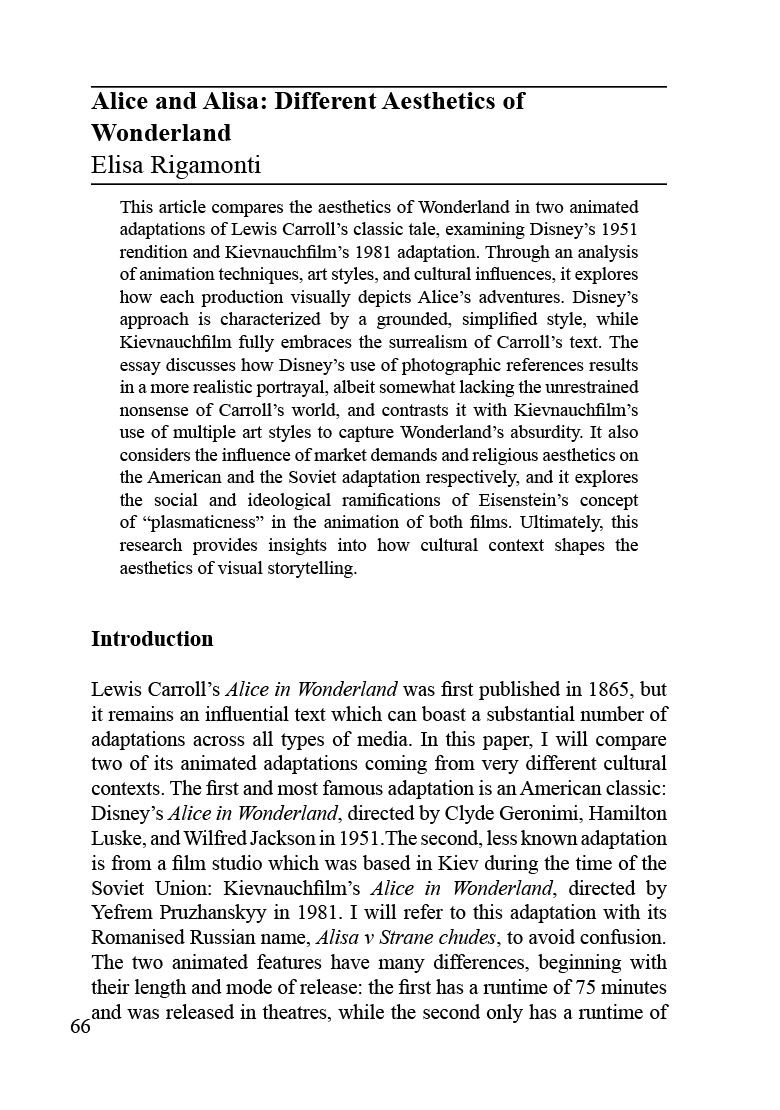Alice and Alisa
Different Aesthetics of Wonderland
DOI:
https://doi.org/10.36399/GroundingsUG.15.138Keywords:
Disney, Kievnauchfilm, Alice in Wonderland, Lewis Carroll, Plasmaticness, Soviet Film, Alisa v Strane chudesAbstract
This article compares the aesthetics of Wonderland in two animated adaptations of Lewis Carroll’s classic tale, examining Disney’s 1951 rendition and Kievnauchfilm’s 1981 adaptation. Through an analysis of animation techniques, art styles, and cultural influences, it explores how each production visually depicts Alice’s adventures. Disney’s approach is characterized by a grounded, simplified style, while Kievnauchfilm fully embraces the surrealism of Carroll’s text. The essay discusses how Disney’s use of photographic references results in a more realistic portrayal, albeit somewhat lacking the unrestrained nonsense of Carroll’s world, and contrasts it with Kievnauchfilm’s use of multiple art styles to capture Wonderland’s absurdity. It also considers the influence of market demands and religious aesthetics on the American and the Soviet adaptation respectively, and it explores the social and ideological ramifications of Eisenstein’s concept of “plasmaticness” in the animation of both films. Ultimately, this research provides insights into how cultural context shapes the aesthetics of visual storytelling.
References
Blackledge, Olga. “Violence, Chases and the Construction of Bodies in American and Soviet Animated Series.” Animation 5, no. 1 (2010): 41-56. https://doi-org.ezproxy2.lib.gla.ac.uk/10.1177/1746847709356642.
Bye, Susan. “Imagination and invention: ‘Alice in wonderland’ on screen.” Screen Education, no. 92 (2019): 30-37.
Carroll, Lewis. Alice’s Adventures in Wonderland. Reprint edition. New York: HarperCollins, 2010.
Chaston, Joel D. “The ‘Ozification’ of American Children’s Fantasy Films: The Blue Bird, Alice in Wonderland, and Jumanji.” Children’s Literature Association Quarterly 22, no. 1 (1997): 13-20. https://doi.org/10.1.353/chq.0.1124.
Eisenstein, Sergei. Eisenstein on Disney. Edited by Jay Leyda. London: Methuen, 1988.
Fahmi, Marwa Essam Eldin. “Fantasy Chronotope in Two Animated Children’s Films: Walt Disney’s Alice in Wonderland (1951) and Hayao Miyazaki’s Spirited Away (2001).” Studies in Literature and Language 14, no. 1 (2017): 28-38. http://dx.doi.org/10.3968/9120.
Finch, Christopher. The Art of Walt Disney: from Mickey Mouse to the Magic Kingdoms. Edited by Andrea Danese. New York: Harry N. Abrams, 2004.
Furuhata, Yuriko. “Rethinking Plasticity: The Politics and Production of the Animated Image.” Animation 6, no. 1 (2011): 25-38. https://doi-org.ezproxy2.lib.gla.ac.uk/10.1177/1746847710391226.
Hanada, Kiyoteru. “Cheshire Cat.” Translated by Robin Thompson. Art in Translation 8, no. 1 (2016): 79-91. https://doi.org/10.1080/17561310.2016.1143710.
Liao, Yanni. “The influence of Russian religious aesthetics on Russian animation.” Visual Studies (2023): 1-11. https://doi.org/10.1080/1472586X.2023.2259350.
MacFadyen, Donald. Yellow crocodiles and blue oranges: Russian animated film since World War Two. Montreal: McGill-Queen’s University Press, 2005.
Ross, Doris. “Escape from wonderland: Disney and the female imagination.” Marvels & Tales 18, no. 1 (2004): 53-66. https://www.jstor.org/stable/41388684.
Geronimi, Clyde, Wilfred Jackson and Hamilton Luske, directors. Alice in Wonderland. RKO Radio Pictures, 1951.
Pruzhanskyy, Yefrem, director. Alice in Wonderland. Kievnauchfilm, 1981.
Sharpsteen, Ben, director. Dumbo. RKO Radio Pictures, 1941.

Downloads
Published
Issue
Section
License
Copyright (c) 2024 Elisa Rigamonti

This work is licensed under a Creative Commons Attribution 4.0 International License.
The CC BY 4.0 license is a Creative Commons license. This is a non-copyleft free license that is good for art and entertainment works, and educational works. It is compatible with all versions of the GNU GPL; however, like all CC licenses, it should not be used on software. People are free to: Share — copy and redistribute the material in any medium or format; Adapt — remix, transform, and build upon the material for any purpose, even commercially. The licensor cannot revoke these freedoms as long as you follow the license terms. But they must conform to the following terms: Attribution — You must give appropriate credit, provide a link to the license, and indicate if changes were made. You may do so in any reasonable manner, but not in any way that suggests the licensor endorses you or your use. No additional restrictions — You may not apply legal terms or technological measures that legally restrict others from doing anything the license permits.
Please check individual article PDF copies to see if any additional restrictions apply.







